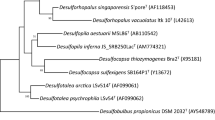Abstract
From granular sludge of an upflow anaerobic sludge bed (UASB) reactor treating paper-mill wastewater, a sulfate-reducing bacterium (strain ASRB1) was isolated with acetate as sole carbon and energy source. The bacterium was rod-shaped, (1.4–1.9 × 2.5–3.4 μm), non-motile, and gram-negative. Optimum growth with acetate occurred around 37° C in freshwater medium (doubling time: 3.5–5.0 days). The bacterium grew on a range of organic acids, such as acetate, propionate, and butyrate, and on alcohols, and grew autotrophically with H2, CO2, and sulfate. Fastest growth occurred with formate, propionate, and ethanol (doubling time: approx. 1.5 days). Strain ASRB1 clusters with the delta subdivision of Proteobacteria and is closely related to Syntrophobacter wolinii, a syntrophic propionate oxidizer. Strain ASRB1 was characterized as a new genus and species: Desulforhabdus amnigenus.
Similar content being viewed by others
Author information
Authors and Affiliations
Additional information
Received: 9 January 1995 / Accepted: 8 April 1995
Rights and permissions
About this article
Cite this article
Elferink, S., Maas, R., Harmsen, H. et al. Desulforhabdus amnigenus gen. nov. sp. nov., a sulfate reducer isolated from anaerobic granular sludge. Arch Microbiol 164, 119–124 (1995). https://doi.org/10.1007/s002030050243
Issue Date:
DOI: https://doi.org/10.1007/s002030050243




